Apple iPhone 4S: Thoroughly Reviewed
by Anand Lal Shimpi & Brian Klug on October 31, 2011 7:45 PM EST- Posted in
- Smartphones
- Apple
- Mobile
- iPhone
- iPhone 4S
Improved Baseband - No Deathgrip
We’ve mentioned already that the 4S is more of an evolution of the CDMA iPhone 4 than the GSM/UMTS iPhone 4, and where that’s most obvious is again is its cellular architecture. When we reviewed the GSM/UMTS iPhone 4, we investigated and explained why its design made it especially prone to unintended attenuation when held a certain way. Apple remedied the situation somewhat by giving away free cases, but only in the case of the CDMA iPhone 4 was the fundamental design issue remedied by adding receive diversity with a second cellular antenna at the top.
The 4S builds on this architecture by incorporating the same diverse receive path with two U shaped antennas at top and bottom, and adding transmit diversity to the equation. I’m being a bit fast and loose with the term “diversity” here, since the 4S cannot transmit simultaneously on both antennas, but rather switches between the two antennas based on which has the least receive fading. Receive diversity is a bit more interesting to explain, since the 4S appears to be able to dynamically decide whether to select one of the two receive paths (in the case that one is much more faded than the other), or combine the two (using something like maximal-ratio combining) and get a better quality equivalent signal.
When I talked about the CDMA 4’s receive diversity scheme, I went into detail to prove that this feature was present. With the 4S, these diversity features are much easier to talk about because Apple has been directly forthcoming about the feature this time. In addition, the transmit switching part of the equation is discussed at length in Apple’s FCC disclosure (since the FCC is interested in scrutinizing transmitters), and even includes a nice diagram.
The device is capable of switching between the Primary/ANT1 and Secondary/ANT2 Antennas. The antenna switching is implemented with a physical, "break-before-make" switch such that only one antenna can be used for cellular transmission at a time.
To re-state the evolution that Apple has taken with this design, the GSM/UMTS 4 had one transmit and receive chain, the CDMA 4 added a second receive chain for diversity, and the 4S now has two receive chains and the ability to switch between two transmit chains. The result is that the phone no longer is prone to fading on either the forward or reverse link due to being held near the feed points for one chain.
To be totally thorough, you can immediately see that the 4S still incorporates the same overall design however, complete with a a U.FL connector at the bottom and a feed cable that runs up the side of the PCB to the top. From here it obviously terminates somewhere that makes contact with the top antenna.

Encircled in red: Top antenna feed cable (Original photo courtesy iFixit)
When we saw that the CDMA iPhone used Qualcomm’s MDM6600, we made an educated guess that the next device would likely be based on the same baseband. It turned out that this was pretty close to the case, as the iPhone 4S uses an unannounced Qualcomm MDM6610.
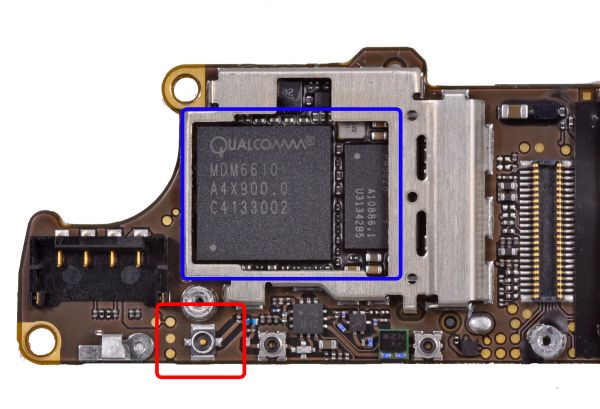
Encircled in blue: Qualcomm MDM6610 and PM8028, Red: Bottom antenna U.FL connector. Note to the right the two test pads for the two chains. (Original photo courtesy iFixit)
There are some immediate differences that stick out about MDM6610 versus MDM6600. First, 6610 doesn’t appear to include an internal transceiver, unlike MDM6600 which previously included a transceiver in its package. MDM6610’s package is correspondingly smaller, at 10x10 mm, compared to 6600’s 9.8x12.2 mm, but again you have to factor in the fact that the transceiver isn’t inside that package anymore. Based on those facts and the state of 28nm maturity, it’s almost certain that MDM6610 is still a 45nm part. The 4S uses Qualcomm’s RTR8605 IntelliCeiver transceiver for cellular RF management and also for GLONASS/GPS. We’ve seen RTR8600 before, and RTR8605 appears to just be an improvement upon that part with the same functionality. In fact, inside the MDM6610’s AMSS it’s just referred to as RTR8600.
Qualcomm isn’t ready to talk at all about MDM6610, but I’ve done a little digging and know more about this part. First off, it’s referred to as codename “Trek” inside the Qualcomm AMSS (Advanced Mobile Subscriber Software), whereas MDM6600 in the CDMA iPhone was referred to as “Phoenix.” When we first saw that the 4S was using a baseband that hasn’t been announced, we assumed it was an Apple specific one-off. However, after some digging I uncovered a reference to a GSM/UMTS only part as well: “MDM6210MDM6610”. For those that aren’t familiar, the 2 connotes GSM/UMTS compatibility, 6 adds 1x/EVDO. Apple appears to have secured MDM6610 exclusivity for the time being, but I expect we’ll see a more formal announcement of the MDM6x10 family down the road. This is pretty much par for the course for Apple when it comes to component sourcing.
| iPhone 4S - Network Support | |||||
| GSM/EDGE Support | 850 / 900 / 1800 / 1900 MHz | ||||
| UMTS/HSDPA/HSUPA Support | 850 / 900 / 1900 / 2100 MHz | ||||
| HSDPA/HSUPA Speeds | 14.4 Mbps / 5.76 Mbps | ||||
| CDMA2000 1x/EVDO Support | EVDO Rev.A (800 / 1900 MHz) | ||||
| Baseband Hardware | Qualcomm MDM6610 | ||||
MDM6610 also appears to inherit all the air interfaces that MDM6600 had, including WCDMA/HSPA+ with HSDPA 14.4, HSUPA 5.76, GSM, CDMA 1x/EVDO (up to Rev.B, though Apple notes only A is used at present), and finally GPS/GLONASS. Superficially, there don’t appear to be any major differences beyond using an external transceiver to accommodate diversity and transmit switching. In addition, the 4S contains all the same bands as the GSM/UMTS iPhone 4.
I was initially worried that Apple would go the same route that it did with both iPhone 4 launches and initially not include FieldTest. Thankfully, the 4S includes FieldTest right out of launch, which works for both CDMA and GSM/UMTS provisioned 4Ses.

iPhone 4S Field Test under CDMA Mode
There’s a corresponding difference in the interface for the two modes. On CDMA iPhone 4S mode, there are tabs for 1x and EVDO, and Rx signal strength fields for both receive paths, as well as the current transmit power. What’s interesting here is that when using the 4S in CDMA mode, you can see the receive strength change for each antenna when held.
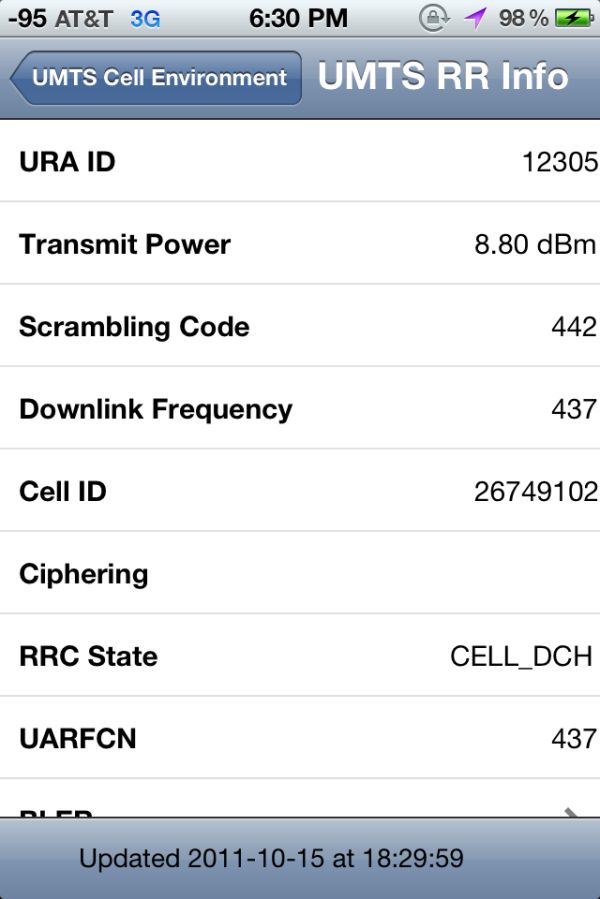
iPhone 4S Field Test under UMTS/GSM Mode
On the GSM/UMTS provisioned iPhone 4S, you don’t get individual receive strength for each chain, instead just the effective RSCP from either the selected chain or combined. If you grip the phone while watching this, you can sometimes watch RSCP race to –130 dBm and then switch entirely to the other antenna and race back up to an acceptable number. As a reminder, to get into FieldTest dial *3001#12345#* - you can then keep numerics instead of bars in the top left by force quitting FieldTest after launching it (hold down power/lock until power off appears, then hold the home button).
So how does the 4S do in our actual attenuation testing? Very well actually. I watched the RSCP of one NodeB and held the 4S all the same ways we’ve done since the 4, recorded a bunch of data, and averaged it together. What we’re measuring here is reported in dBm, and less attenuation is better (0 dBm = 1 mW).
| Signal Attenuation Comparison in dB - Lower is Better | ||||||||
| Cupping Tightly | Holding Naturally | Holding in Case | On an Open Palm | |||||
| iPhone 4S | 10.8 | 8.8 | - | 4.3 | ||||
| CDMA iPhone 4 | 16.5 | 15.5 | 9.0 | 7.9 | ||||
| GSM/UMTS iPhone 4 | 24.6 | 19.8 | 7.2 | 9.2 | ||||
| Samsung Galaxy S 2 | 18.4 | 5.9 | - | 12.2 | ||||
| Droid 3 | 16.0 | 11.3 | - | 5.0 | ||||
| HTC Sensation | 15.0 | 10.0 | 8.0 | 0.0 | ||||
| Samsung Droid Charge | 10.0 | 10.0 | 5.0 | 0.0 | ||||
| HTC Thunderbolt - LTE | 5.3 | 2.5 | - | 4.4 | ||||
| HTC THunderbolt - EVDO | 6.5 | 0.8 | - | 7.2 | ||||
| LG Optimus 2X | 13.7 | 9.3 | - | 5.9 | ||||
| Nexus S | 13.3 | 6.1 | - | 4.3 | ||||
| Droid 2 | 11.5 | 5.1 | - | 4.5 | ||||
| BlackBerry Torch | 15.9 | 7.1 | - | 3.7 | ||||
| Dell Streak | 14.0 | 8.7 | - | 4.0 | ||||
| Droid X | 15.0 | 5.1 | - | 4.5 | ||||
| iPhone 3GS | 14.3 | 1.9 | 3.2 | 0.2 | ||||
| HTC Nexus One | 17.7 | 10.7 | 7.7 | 6.7 | ||||
When we reviewed the CDMA iPhone 4, I made mention of the fact that this was the first iPhone 4 I felt comfortable using without a case. This same confidence continues with the 4S, which is in practice completely usable without a case, unlike the GSM/UMTS iPhone 4. Since launch time, Anand and myself have been using our 4Ses without cases, and the difference is dramatic.


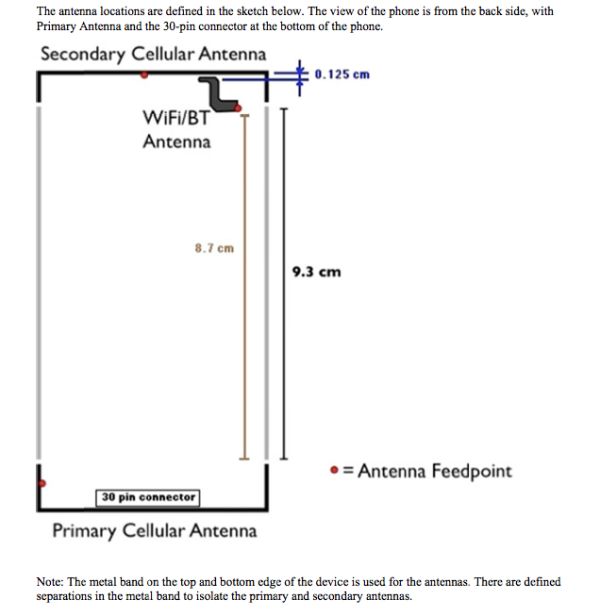
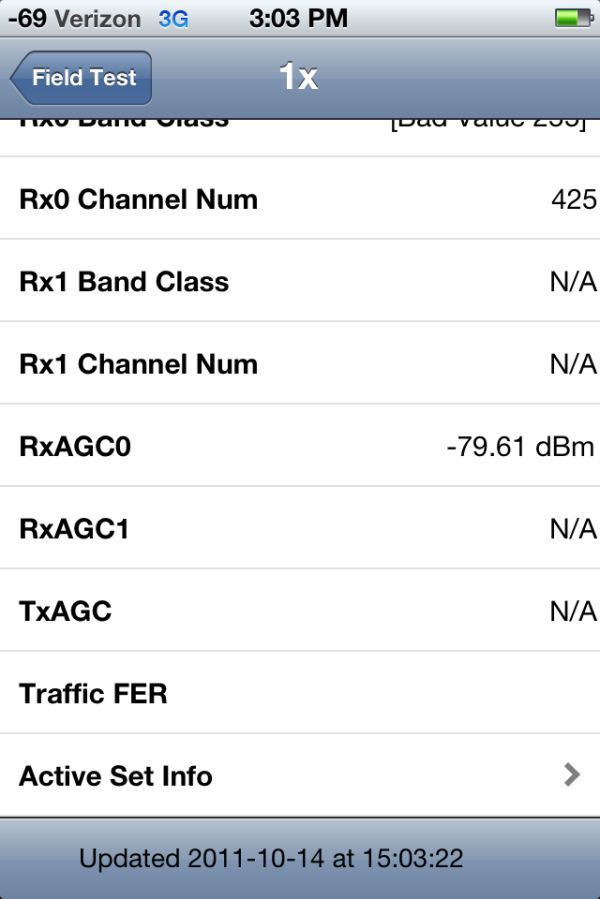
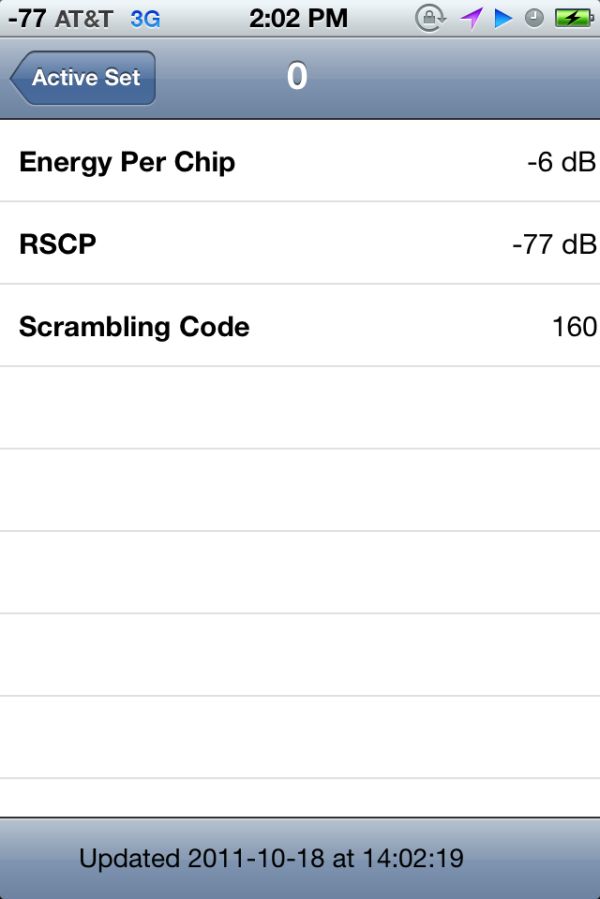








199 Comments
View All Comments
metafor - Tuesday, November 1, 2011 - link
Fair enough. But that really doesn't take away from the fact that the A5 is a relatively large chip and from the UV-scans of it, looks to use quite a bit of that die area for the GPU.I don't know if a similar scan has been done of Exynos but one can't safely say both chips are far bigger than SoC's traditionally used in this space.
Though that trend appears to be moving forward with MSM8960 and Tegra 3.....
PeteH - Tuesday, November 1, 2011 - link
That leads to an interesting question: will Apple always have the largest SoCs, and thus (most likely) the highest performance in the mobile space?The reason I could see this happening is that Apple doesn't have to sell their SoC's at a profit, so they're paying closer to cost for the chips (excluding the fab mark up). Other manufacturers (like NVIDIA) need to make a profit on their chips.
name99 - Thursday, November 3, 2011 - link
"I'm not entirely sure why they had to use such a powerful GPU, though. "And you know EXACTLY how Apple use the GPU do you?
Does Siri run some of its workload on the GPU? Does the faster camera stuff (eg fast HDR) run on the GPU? Does Apple already have OpenCL running (for internal use) on iOS?
doobydoo - Friday, December 2, 2011 - link
He must be an Android fan.Androids new marketing campaign will offer a revolutionary 'new' feature - the ability to have a slower GPU than other phones!!!
Magical.
InternetGeek - Monday, October 31, 2011 - link
They might give AMD and nVidia a run for their money if they ever tried creating desktop products...sprockkets - Monday, October 31, 2011 - link
Kyro 2 was a good chip, but obviously went to focus on the desktop market.tipoo - Tuesday, November 1, 2011 - link
Maybe, but there's a reason such crossovers usually take so long. Look at Intel trying to get into this space, I don't doubt they will be good at it but it takes years of development. Imagination specializes in low power, it would take lots of development effort to get into the high power desktop game._tangent - Tuesday, November 1, 2011 - link
I think this might be intentionally ironic given they got out of that game a long time ago :POn point though, anyone would given AMD and nVidia a run for their money with the right up front cash and expertise. I imagine the barrier to entry into that market is truly colossal though. Point is, the SGX543 MP2 is no evidence one way or the other.
lurker22 - Monday, October 31, 2011 - link
Before buying many people who got a 4s on AT&T told me how much better it was than their prior AT&T iphones.Anand, thanks for confirming and explaining the reasons.
LordSojar - Monday, October 31, 2011 - link
Can't we have reviews as detailed as this for the really big name Android phones? They are always far less detailed and lack a lot of the testing put into this.... thing....Apple makes a few adjustments, tweaks a few things, adds in the same processor that's in the iPad 2, and we have a highly detailed, scientific review that covers every single aspect, even if said aspects are the same. Samsung releases a new phone that has overall better features, faster CPU, faster NAND, a different and arguably better (or at least equal) screen, and mums the word?
The bias is getting a bit out of hand at this point... We get that you're big time Apple fans, but cmon... At least do a major review of this caliber for the Droid RAZR and the Samsung Galaxy Nexus and the Galaxy S2 Skyrocket (LTE on AT&T!). Even if you combine them into one review, just make it THIS detailed for once instead of giving Apple the huge, super detailed ultra review!